冀教版三年级英语上册Lesson 25
冀教版小学英语三年级上册全册教学课件(2021年9月修订)

Homework
假如你要把你的新朋友介绍给你的妈妈,你 们会说些什么呢?请你把你们的对话写下来。
提示:1. What's his/her name? 2. His/ Her name is...
Summary
学生课堂行为规范的内容是: 按时上课,不得无故缺课、迟到、早退。
name is
. What’s your name?
Presentation
Let’s sing
点击,播放视频
Presentation
Hello! My name is Jenny. What's your name?
Let’s act
My name is Danny.
Consolidation
his 他的; 用于男性 her 她的; 用于女性
Presentation
Let’s play
My name is Li Ming.
My name is Jenny. His name is Li Ming.
My name is Danny. His name is Li Ming. Her name is Jenny.
这是一句比较正式 的问候用语。
Presentation
Let’s learn
Thanks./Thank you. 谢谢。 这是最常用的感谢语。
2. —What’s this? —It’s a …
Warming up
Let’s guess
Today is Monday. Li Ming and Jenny go to school. They meet outside the school. What will they say?
(冀教版)三年级英语上册《unit 4 Lesson 25》教案设计4
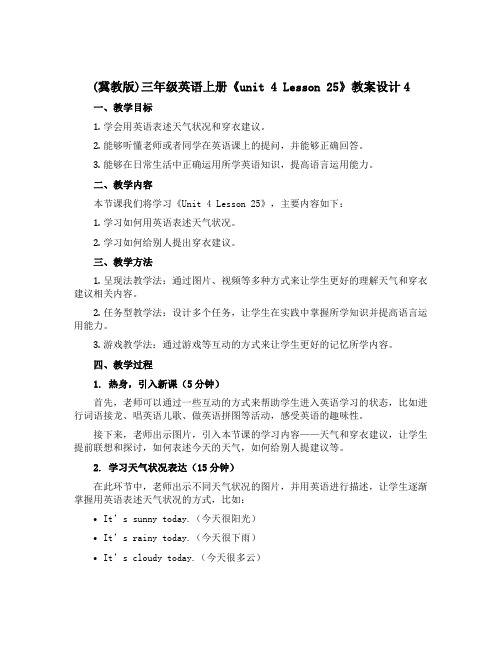
(冀教版)三年级英语上册《unit 4 Lesson 25》教案设计4一、教学目标1.学会用英语表述天气状况和穿衣建议。
2.能够听懂老师或者同学在英语课上的提问,并能够正确回答。
3.能够在日常生活中正确运用所学英语知识,提高语言运用能力。
二、教学内容本节课我们将学习《Unit 4 Lesson 25》,主要内容如下:1.学习如何用英语表述天气状况。
2.学习如何给别人提出穿衣建议。
三、教学方法1.呈现法教学法:通过图片、视频等多种方式来让学生更好的理解天气和穿衣建议相关内容。
2.任务型教学法:设计多个任务,让学生在实践中掌握所学知识并提高语言运用能力。
3.游戏教学法:通过游戏等互动的方式来让学生更好的记忆所学内容。
四、教学过程1. 热身,引入新课(5分钟)首先,老师可以通过一些互动的方式来帮助学生进入英语学习的状态,比如进行词语接龙、唱英语儿歌、做英语拼图等活动,感受英语的趣味性。
接下来,老师出示图片,引入本节课的学习内容——天气和穿衣建议,让学生提前联想和探讨,如何表述今天的天气,如何给别人提建议等。
2. 学习天气状况表达(15分钟)在此环节中,老师出示不同天气状况的图片,并用英语进行描述,让学生逐渐掌握用英语表述天气状况的方式,比如:•It’s sunny today.(今天很阳光)•It’s rainy today.(今天很下雨)•It’s cloudy today.(今天很多云)老师可以这样让学生进行练习,老师描述天气,带领学生一起说对应的天气句子,再让学生独立说出天气句子。
3. 学习穿衣建议(15分钟)在此环节中,首先app为了让学生直观的理解怎么根据天气状况穿衣服,老师可以先出示一些穿衣的图片,然后引导学生一起说出应该穿什么衣服。
之后,老师可以通过模拟不同天气状况下,给学生提出穿衣建议,让学生根据提供的建议,说出应该穿什么衣服。
比如:•It’s cold today. You should wear a coat.(今天很冷,你应该穿上外套)•It’s hot today. You should wear shorts.(今天很热,你应该穿短裤)4. 游戏环节(20分钟)在此环节中,老师设计一个游戏,让学生在游戏的过程中复习所学的知识和技巧,同时又能够在游戏中提高语言运用能力。
冀教三年级上册英语全册课件(2021年秋修订)

cap 帽子
Language points
What is she wearing? 她正穿着一件什么? 此句用于询问某人正穿戴着什么衣物。 句型结构为: What + be动词+主语+wearing? 答语为:主语+be动词+wearing+衣物.
Let’s do it!
Read and draw.
New words
coat
大衣;外套
cap
(有帽舌的)帽子
Miss
小姐,女士 (用于未婚女子姓氏或
姓名前,以示礼貌)
What is she wearing?
She is wearing a coat. It’s nice.
她穿着一件大衣。它很漂亮。
coat 大衣,外套
scarf 围巾
gloves 手套
He is wearing an orange shirt.
He is wearing red trousers.
She is wearing a red dress.
New words
is
是 (用于he, she, it 及单数可数名词和
不可数名词后)
are
是 (用于we, you, they及复数名词后)
物品是否属于对方的句子,意为“这是你的……吗?” 其答语为: Yes, it is. 是的,它是。 No, it isn’t. 不,它不是。
2. Danny, are these your gloves? 丹尼,这是你的手套吗? “Are these your + 复数名词?”询问近处多个物品
是否属于对方的句子,意为“这些是你的……吗?” 其答语为: Yes, they are. 是的,它们是。 No, they aren’t. 不,它们是。
冀教版三年级上册UNIT3《Lesson25 Family》word教案3篇

(冀教版)三年级英语上册教案Unit 3 Lesson 25 FamilyClass Opening and ReviewGREETINGSING A SONGLet the class choose a favourite Song.New Concepts1. Cry(ing), laugh(ing), sing(ing), play(ing), talk(ing).DEMONSTRATEDo actions to demonstrate cry, laugh, sleep and play as you say the words with the class. Write the words on the blackboard and have the students repeat them as you point to each word.STUDENT BOOK: L25 N1Discuss the pictures in the student book. Use as much English as possible. For example, with gestures, try questions such as:Point to someone laughing.Is he/she happy or sad?Where is someone talking?What are they saying?Why is the little girl crying?Play the audiotape as the students follow in their books.DRILLLead the class through a question-and-answer drill such as:Teacher: What‟s he/she doing? What‟s he/she doing? Say it, please.Class: What‟s he/she doing?Teacher: What‟s he/she doing? (Point to a picture in the student book.)Class: He/She is __ ing.Ask a volunteer to stand at his or her desk and perform any one of the five actions and repeat the drill. V olunteers may also perform other actions the students can name, such as walking, jumping, pointing and drawing. Move quickly through this exercise.ACTIVITY BOOK: L25 N1This exercise requires the students to underline laugh, cry, sing or, play to match pictures.2. Family, daughter, son, mother, father.STUDENT BOOK: L25 N2.3Explain that the class will learn about families.Lead the class in a discussion about the pictures in the student book of Jenny‟s family and Li Ming‟s family. For example, ask the students what they notice about the organization of the pictures. Why are the pictures organized that way? Make statements about the pictures that review the vocabulary and link the concepts of boy/man with son/father, and girl/woman with daughter/mother.For example:He/She is a boy/girl. He/She is a son/daughter.Son/Daughter. Say it, please.Where is Jenny? This is Jenny‟s family.(Circle Jenny‟s family.)This is Jenny‟s father/mother.He/She is a man/woman.Father/Mother.This is Li Ming‟s father. He is a man.He is a father. Father.Play the audiotape as the students follow in their books.DRILLLead the class in a drill about family members. For example, draw a rough picture of a family on the blackboard. Point to people in the picture and ask questions such as: Teacher: Is this a _____or a ____?Class: A ____.Teacher: Is he a daughter?Class: No, he‟s a son/father.Remember to call on individual students sometimes and sometimes groups of students or the whole class. As the students reply, write the word on the blackboard with an arrow drawn to the correct person.ACTIVITY BOOK: L25 N2.3In Number 2, the students match words for family members with pictures by writing the correct letter in each circle.In Number 3, the students draw a picture of their own family and label the people in it with the new family vocabulary. Show the students the word list at the bottom of the exercise. Some of the students may want to add more people than they can label in English. This would provide you with a natural opportunity to supplement their vocabulary with words such as aunt, uncle, cousin, niece and nephew.Class ClosingSING “IF YOU‟RE HAPPY AND YOU KNOW IT”Do the song with a variation. Ask half the class only to sing and the other half only to do the actions.(冀教版)三年级英语上册教案unit4 Lesson25Lesson 25 Family教学目标:通过本课教学使学生掌握下列单词:cry, laugh, sing, play, talk, family, daughter, son, mother, father.教学重点:father, mother, son, daughter.教学难点:句型的掌握:They are talking. They are singing. She is crying. He is laughing.教具学具:图片、卡片、录音机、学生自己动手画的图片。
冀教版三年级上册UNIT3《Lesson25Family》word教案3篇

(冀教版)三年级英语上册教案Unit 3 Lesson 25 FamilyClass Opening and ReviewGREETINGSING A SONGLet the class choose a favourite Song.New Concepts1.Cry(ing), laugh(ing), sing(ing), play(ing), talk(ing).DEMONSTRATEDo acti ons to dem on strate cry, laugh, sleep and play as you say the words with the class. Write the words on the blackboard and have the stude nts repeat them as you point to each word.STUDENT BOOK: L25 N1Discuss the pictures in the student book. Use as much English as possible. For example, with gestures, try questi ons such as:Point to some one laugh ing.Is he/she happy or sad?Where is some one talk ing?What are they say ing?Why is the little girl cryin g?Play the audiotape as the students follow in their books.DRILLLead the class through a questi on-an d-a nswer drill such as:Teacher: What?s he/she doing? What?s he/she doing? Say it, please.Class: What?s he/she doi ng?Teacher: What?s he/she doing? (Po int to a picture in the stude nt book.)Class: He/She is __ ing.Ask a volun teer to sta nd at his or her desk and perform any one of the five acti ons and repeat the drill. Volunteers may also perform other actions the students can name, such as walk ing, jump ing, pointing and draw ing. Move quickly through this exercise.ACTIVITY BOOK: L25 N1This exercise requires the stude nts to un derli ne laugh, cry, sing or, play to match pictures.2.Family, daughter, son, mother, father.STUDENT BOOK: L25 N2.3Explain that the class will learn about families.Lead the class in a discussi on about the pictures in the stude nt book of Jenny?s family and Li Ming?s family. For example, ask the students what they notice about the organization of the pictures. Why are the pictures organized that way? Make statements about the pictures that review the vocabulary and link the concepts of boy/ma n with son /father, and girl/woma n with daughter/mother.For example:He/She is a boy/girl. He/She is a son/daughter.Son/Daughter. Say it, please.Where is Jenny? This is Jenny?s family.(Circle Jenny?s family.)This is Jenny?s father/mother.He/She is a man/woma n.Father/Mother.This is Li Min g?s father. He is a man.He is a father. Father.Play the audiotape as the students follow in their books.DRILLLead the class in a drill about family members. For example, draw a rough picture of a family on the blackboard. Point to people in the picture and ask questi ons such as: Teacher: Is this a ___ or a ?Class: A _______ .Teacher: Is he a daughter?Class: No, he?s a son /father.Remember to call on individual students sometimes and sometimes groups of students or the whole class. As the students reply, write the word on the blackboard with an arrow drawn to the correct person.ACTIVITY BOOK: L25 N2.3In Number 2, the students match words for family members with pictures by writing the correct letter in each circle.In Number 3, the students draw a picture of their own family and label the people in it with the new family vocabulary. Show the students the word list at the bottom of the exercise. Some of the students may want to add more people than they can label in English. This would provide you with a natural opportunity to supplement their vocabulary with words such as aunt, uncle, cousin, niece and nephew.Class ClosingSING “IF YOU?RE HAPPY AND YOU KNOW I”TDo the song with a variation. Ask half the class only to sing and the other half only to do the actions.(冀教版)三年级英语上册教案unit4 Lesson25Lesson 25 Family 教学目标:通过本课教学使学生掌握下列单词:cry, laugh, sing, play, talk, family, daughter, son, mother, father.教学重点:father, mother, son, daughter.教学难点:句型的掌握:They are talking. They are singing. She is crying. He is laughing.教具学具:图片、卡片、录音机、学生自己动手画的图片。
(冀教版)三年级英语上册《unit 4 Lesson 25》教学设计设计2
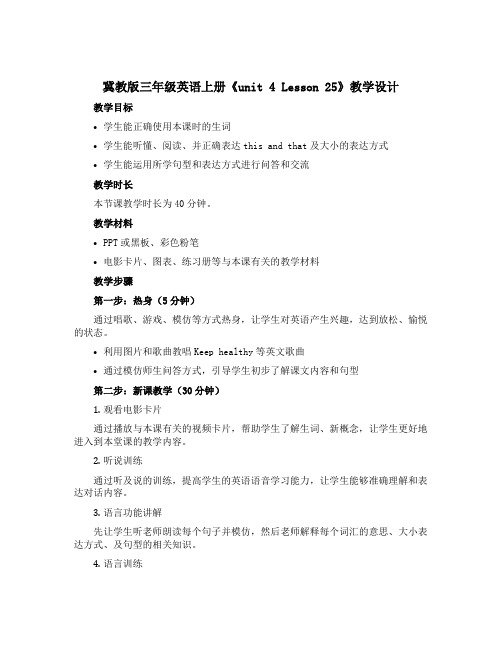
冀教版三年级英语上册《unit 4 Lesson 25》教学设计教学目标•学生能正确使用本课时的生词•学生能听懂、阅读、并正确表达this and that及大小的表达方式•学生能运用所学句型和表达方式进行问答和交流教学时长本节课教学时长为40分钟。
教学材料•PPT或黑板、彩色粉笔•电影卡片、图表、练习册等与本课有关的教学材料教学步骤第一步:热身(5分钟)通过唱歌、游戏、模仿等方式热身,让学生对英语产生兴趣,达到放松、愉悦的状态。
•利用图片和歌曲教唱Keep healthy等英文歌曲•通过模仿师生问答方式,引导学生初步了解课文内容和句型第二步:新课教学(30分钟)1.观看电影卡片通过播放与本课有关的视频卡片,帮助学生了解生词、新概念,让学生更好地进入到本堂课的教学内容。
2.听说训练通过听及说的训练,提高学生的英语语音学习能力,让学生能够准确理解和表达对话内容。
3.语言功能讲解先让学生听老师朗读每个句子并模仿,然后老师解释每个词汇的意思、大小表达方式、及句型的相关知识。
4.语言训练通过老师给出的口头练习,让学生更好地掌握所学句型,并运用所学知识进行交流练习,以达到掌握目的。
5.任务呈现将所学知识点和句型运用到真实语境中,以小组讨论或问答的方式,完成预设任务,并展示学生的学习成果。
第三步:复习与学以致用(5分钟)通过随机提问的方式,对所学知识点进行复习,并鼓励学生在日常生活中多运用英语,提高学生的英语语感和实际应用能力。
教学评估通过老师提问、小组讨论、作业等方式对学生的掌握情况进行评估,将学生的表现纳入评分系统,并及时反馈学生优缺点,协助学生找到提高学习成绩的方法和路径。
(冀教版)三年级英语上册《unit 4 Lesson 25》教案设计

(冀教版)三年级英语上册《unit 4 Lesson 25》教案设计教学背景此教案适用于三年级上册的英语教学,针对的是第四单元的第25课,教学重点为学习介绍个人常用物品及其用途。
教学目标知识目标:1.学生能够掌握一些常用物品的英语名称。
2.学生能够描述这些物品的用途。
3.学生能够与同学交流自己所持有的物品,以及这些物品的用途。
能力目标:1.学生能够通过观察和描述物品,学会用英语描述周围的事物。
2.学生能够通过和同学互相交流,提高英语口语交流的能力。
情感目标:1.学生能够感受到英语学习的乐趣,增强学习兴趣。
2.学生能够体验到用英语与同学交流的合作与快乐。
教学重难点1.教学重点:学生能够掌握一些常用物品的英语名称。
2.教学难点:学生能够描述这些物品的用途。
教学内容及方法内容本课时将介绍一些常用的英语物品名称及其用途。
方法1.通过图片或实物展示,帮助学生认识和学习物品的名称。
2.利用情境化的对话和问题,锻炼学生口语表达能力。
3.通过交际创设情景,练习学生的语言运用能力。
教学过程Step1 导入新课1.教师打开课件,向学生展示一些常用的生活物品,如水杯、书包、铅笔等,让学生看到物品的图片并辨认出物品的英语名称。
2.通过图片的介绍和物品的描述,让学生了解每种物品的用途。
Step2 学习新词汇1.教师口头或书写方式介绍新单词,让学生跟着念几遍,掌握这些生活物品的英语名称。
2.教师出示物品的图片或实物,让学生能够将英语单词和真实的物品联系起来,以加深对单词的印象。
Step3 热身活动教师根据学生已经掌握的词汇,任选几个单词出来,一边指出物品,一边念出英文单词。
然后让学生根据所念的单词,点出相应的物品。
Step4 情景对话教师可以通过情境化对话,让学生学习怎样使用常用的生活物品。
例如:•A: What’s this?•B: It’s a pen. I use it to write.•A: What’s this in your hand?•B: It’s a book. I read it every day.Step5 练习应用1.进行小组讨论,让学生介绍他们即将使用的物品的名称及其用途,以帮助学生巩固新单词。
(冀教版)三年级英语上册《unit 4 Lesson 25》说课稿4

(冀教版)三年级英语上册《Unit 4 Lesson 25》说课稿课程目标本课程旨在通过练习学生的听力和口语能力,帮助学生学习如何表述自己想要的食物,以及如何礼貌地拒绝他们不想要的食物。
教学重点学习如何用英语表达自己的想法和需要,学习一些新的食品词汇。
教学难点教授学生如何礼貌地拒绝他们不想要的食物。
教学准备黑板、彩色白板笔, Unit 4 Lesson 25 的教材,食物图片(卡片、PPT等)。
教学过程导入新知老师可以通过一些对话或图片向学生介绍本节课的主题:如何表达自己的口味和需求,并礼貌地拒绝不想要的食物。
老师可能会问一些与食品相关的问题,例如“什么食物你最喜欢?”或者“什么食物你不喜欢?”以鼓励学生使用他们已经了解的单词和短语。
观看视频向学生展示一段关于食品的视频,可以是有关学习表达需求和拒绝的一段短片,或一个食品广告短片。
食物品尝准备一些小份食品,并将它们分发给学生。
通过鼓励学生描述它们的味道,形状和颜色,向他们介绍它们的名称,并让他们尝试使用这些新的食品词汇进行描述。
学习新单词和短语介绍一些相关的新单词和短语,如“vegetable”(蔬菜),“fruit” (水果),“I don’t like….” (我不喜欢……)和“I want…”(我想要……)。
通过教授学生如何使用这些单词和短语来构建句子,鼓励他们使用新的词汇来描述他们的食物口味和需求。
语言实践鼓励学生分成小组进行交谈,让他们用之前学到的单词和短语来表达他们的口味和需求,并教授他们如何礼貌地拒绝不想要的食物。
教师可以通过模拟一些情境对学生进行实践,例如餐厅点餐、食物派对和学校午餐。
结束练习回到整个班级的活动中,让学生分享他们在小组内的交流,通过评价对方的练习来鼓励和倡导积极的言论和行为。
教学反思本节课的教学重点是介绍如何表达自己的口味和需求,并礼貌地拒绝不想要的食物。
学生在学习过程中通过观看视频和品尝食物来对具体的食品进行描述,通过语言实践来练习使用新单词和短语。
(冀教版)三年级英语上册《unit 4 Lesson 25》教学设计设计
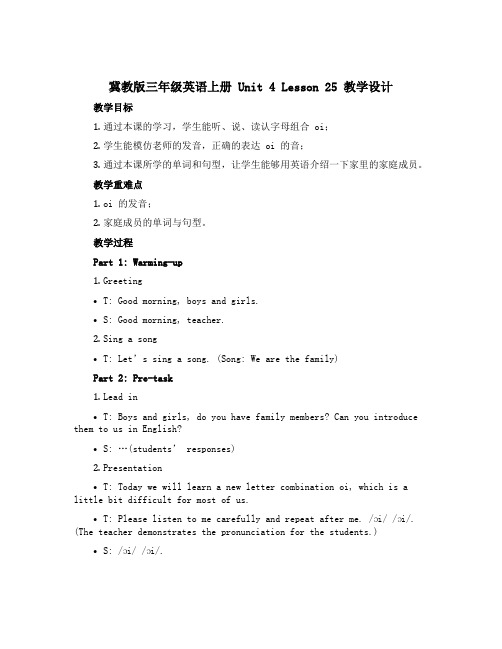
冀教版三年级英语上册 Unit 4 Lesson 25 教学设计教学目标1.通过本课的学习,学生能听、说、读认字母组合 oi;2.学生能模仿老师的发音,正确的表达 oi 的音;3.通过本课所学的单词和句型,让学生能够用英语介绍一下家里的家庭成员。
教学重难点1.oi 的发音;2.家庭成员的单词与句型。
教学过程Part 1: Warming-up1.Greeting•T: Good morning, boys and girls.•S: Good morning, teacher.2.Sing a song•T: Let’s sing a song. (Song: We are the family)Part 2: Pre-task1.Lead in•T: Boys and girls, do you have family members? Can you introduce them to us in English?•S: …(students’ responses)2.Presentation•T: Today we will learn a new letter combination oi, which is a little bit difficult for most of us.•T: Please listen to me carefully and repeat after me. /ɔi/ /ɔi/. (The teacher demonstrates the pronunciation for the students.)•S: /ɔi/ /ɔi/.Part 3: While-task1.Practice•T: Now let’s practice the pronunciation of t he following words. Please listen and repeat after me.•S: (students repeat after the teacher)•T: oil, coin, join, boil, noise, point, boy, toy, enjoy, destroy.•T: Can anyone come to the board and write down the new letter combination?2.Consolidation•T: Now I will show you a picture of my family. Can you help me to introduce them in English? (The teacher shows a picture of her family on the screen. )•S: (students try to introduce the family members in English)Part 4: Post-task1.Production•T: Can you introduce your family members using the new words and sentences we learned today?•S: (students try to introduce their family members in English)2.Homework•T: For your homework tonight, please ask your family members about their names and write them down.教学反思1.教学目标:本节课我从听、说、读认字母组合 oi,句型和单词三个方面出发,让学生将这些知识结合起来,能够描述家人。
(冀教版)三年级英语上册《unit 4 Lesson 25》教案设计3
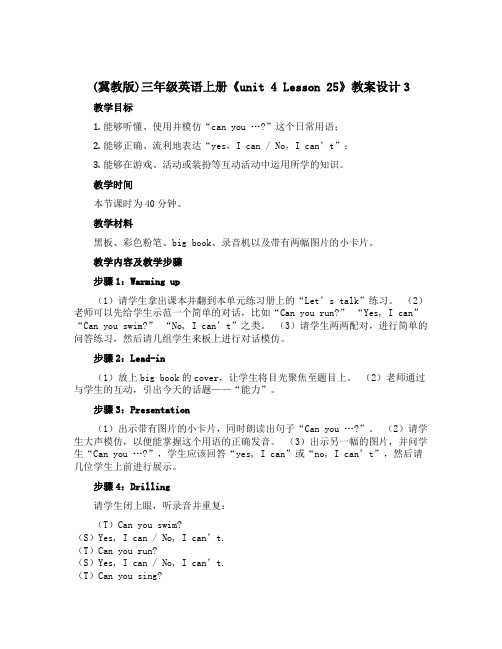
(冀教版)三年级英语上册《unit 4 Lesson 25》教案设计3教学目标1.能够听懂、使用并模仿“can you …?”这个日常用语;2.能够正确、流利地表达“yes,I can / No,I can’t”;3.能够在游戏、活动或装扮等互动活动中运用所学的知识。
教学时间本节课时为40分钟。
教学材料黑板、彩色粉笔、big book、录音机以及带有两幅图片的小卡片。
教学内容及教学步骤步骤1:Warming up(1)请学生拿出课本并翻到本单元练习册上的“Let’s talk”练习。
(2)老师可以先给学生示范一个简单的对话,比如“Can you run?” “Yes, I can” “Can you swim?” “No, I can’t”之类。
(3)请学生两两配对,进行简单的问答练习,然后请几组学生来板上进行对话模仿。
步骤2:Lead-in(1)放上big book的cover,让学生将目光聚焦至题目上。
(2)老师通过与学生的互动,引出今天的话题——“能力”。
步骤3:Presentation(1)出示带有图片的小卡片,同时朗读出句子“Can you …?”。
(2)请学生大声模仿,以便能掌握这个用语的正确发音。
(3)出示另一幅的图片,并问学生“Can you …?”,学生应该回答“yes, I can”或“no, I can’t”,然后请几位学生上前进行展示。
步骤4:Drilling请学生闭上眼,听录音并重复:(T)Can you swim?(S)Yes, I can / No, I can’t.(T)Can you run?(S)Yes, I can / No, I can’t.(T)Can you sing?(S)Yes, I can / No, I can’t.(T)Can you dance?(S)Yes, I can / No, I can’t.步骤5:Practicing(1)请学生站起来,两两交流并出示一张小卡片。
冀教版(一起)三年级英语上册教案Unit4Lesson25(2)
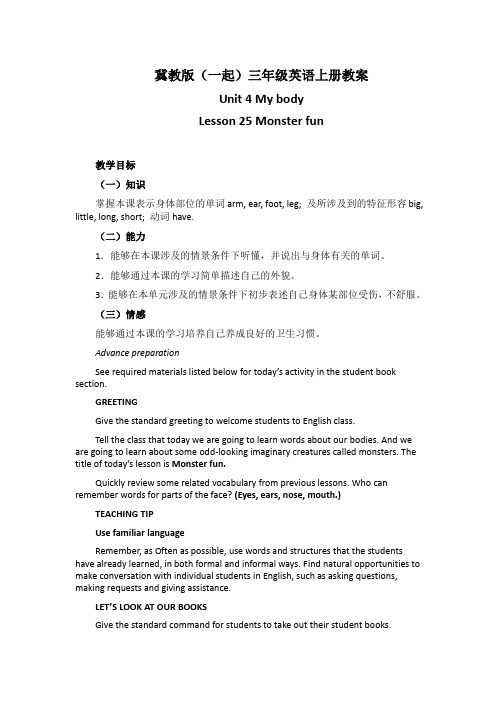
冀教版(一起)三年级英语上册教案Unit 4 My bodyLesson 25 Monster fun教学目标(一)知识掌握本课表示身体部位的单词arm, ear, foot, leg; 及所涉及到的特征形容big, little, long, short; 动词have.(二)能力1.能够在本课涉及的情景条件下听懂,并说出与身体有关的单词。
2.能够通过本课的学习简单描述自己的外貌。
3.能够在本单元涉及的情景条件下初步表述自己身体某部位受伤,不舒服。
(三)情感能够通过本课的学习培养自己养成良好的卫生习惯。
Advance preparationSee required materials listed below for today’s activity in the student book section.GREETINGGive the standard greeting to welcome students to English class.Tell the class that today we are going to learn words about our bodies. And we are going to learn about some odd-looking imaginary creatures called monsters. The title of today’s lesson is Monster fun.Quickly review some related vocabulary from previous lessons. Who can remember words for parts of the face? (Eyes, ears, nose, mouth.)TEACHING TIPUse familiar languageRemember, as Often as possible, use words and structures that the students have already learned, in both formal and informal ways. Find natural opportunities to make conversation with individual students in English, such as asking questions, making requests and giving assistance.LET’S LOOK AT OUR BOOKSGive the standard command for students to take out their student books.Can anybody find the monsters on these pages?1. Long or short, big or small?Discuss the concepts of long and short, big and small. Provide visual clues. For example, you could draw a long line and a short line on the blackboard, and also draw a head with long hair and one with short hair. Or, show a short ruler and a long ruler.For big and small, compare objects of different sizes. Have the students repeat the new words with you.In Chinese, explain that linear size (demonstrate with your arms) is described in English as long or short. Mass size (demonstrate with your arms) is described in English as big or small.Note that the word feet is the plural form of foot. It is an exception to the usual method of forming plurals by simply adding an s.Give the “listen” command. The audiotape will repeat each sentence. Ask the students to listen the first time, then say the words along with the audiotape the second time. The audiotape says:[Monster 1, singing]I have short arms and long legs.I have short arms and long legs.[Monster 2, singing]I have long arms and short legs.I have long arms and short legs.[Narrator]They are singing a song!They are singing a song![Monster 3]I have small ears and big feet.I have small ears and big feet.[Monster 4]I have big ears and small feet.I have big ears and small feet.[Narrator]They are talking. They are talking.Check students’ comprehension. Ask the students to point to the correct part oftheir body when you call out the words: ear, arm, leg. Ask questions such as Which monster has big ears? Which monster has long legs?2. Let’s talk.Give the “listen” command. The audiotape will repeat each line. Ask the students to listen the first time, then say the words along with the audiotape the second time. The audiotape says:[giraffe]I have a long neck. My body is yellow and brown.I have a long neck. My body is yellow and brown.[rabbit]I have long ears and a short tail. My eyes are red.I have long ears and a short tail, My eyes are red.[panda]I have big eyes. My body is white and black.I have big eyes. My body is white and black.TEACHING TIPPronunciation assistanceSome students may have difficulty saying brown correctly. Show them that the / ow / sound in brown is the same as the sound in the Chinese word for dumplings: jiaozi.Use the pictures in the student book to review the new vocabulary. You can either tell the students the English names for these animals (giraffe, rabbit, panda) or refer to them in Chinese. For example, ask the class which animal has a long neck. Which animal has a short tail? Which animal has black on its body?Quickly divide the class into pairs of students. Have the students take turns pretending to be one of these animals while their partner tries to guess which one. The “animal” student will provide clues, using Englis h. When the partner guesses correctly, they switch roles.3. Let’s write and draw.Required materialslarge pieces of white paper, one per studentmarkers for all studentsNote that the verb have conjugates as has in the third person singular. As simply and brief as possible, explain to students that they must write “It has ...”or“He/she has ...” But is correct to say: “I have ...”, “We have ...”or “They have ...”Ask for volunteers to pass out the pieces of paper. Tell the students that they will create a poster of a monster. They will colour their pictures and write some words that describe the picture, using the vocabulary that they learned in today’s lesson. Tell the students that they may ask you for help if they don’t know how to spell a word. Write a list of words that you think may be useful on the blackboard.Have students look at Jenny’s picture of a monster at the bottom of page 51 in the student book. Read aloud to the class what Jenny has written beneath her picture. Does everybody understand wh at to do? Let’s get started!Allow some time for the students to complete their posters. When they are done, collect the completed posters to display in the classroom or elsewhere in the school.LET’S DO SOME EXERCISESGive the standard command for students to take out their activity books.PAGE 54. Write the words. The students write the words for the different parts of the monster’s body, using the list of words at the top. Then they complete the sentences at the bottom, using the list of words at the bottom of the page.PAGE 55. Write and draw! For each pair of sentences, the students write one word in one blank and the other word in the other blank. At the end, they draw and colour a picture that matches the description they have created.CLASS CLOSINGT oday have students number off using some of the vocabulary from today’s lesson: arm, leg, ear, eye and body. Have the class say the words together, then have individual students number off by saying the words in order, from arm to body, until all students have a word. Remind the students to remember their words.When today’s class is over, have the students stand by word. You might say “Now all students with the word eye may stand,” and then move on to another word until all students are standing. Wave and say “Good-bye” to signal that class is over.。
冀教版(一起)三年级英语上册教案Unit4Lesson25(1)
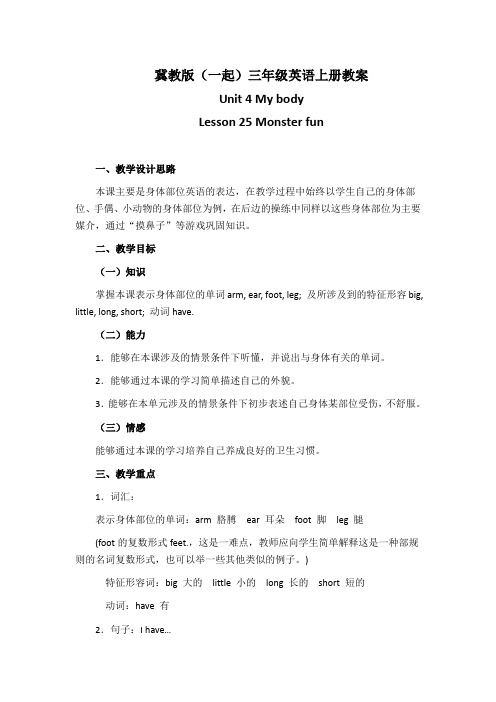
冀教版(一起)三年级英语上册教案Unit 4 My bodyLesson 25 Monster fun一、教学设计思路本课主要是身体部位英语的表达,在教学过程中始终以学生自己的身体部位、手偶、小动物的身体部位为例,在后边的操练中同样以这些身体部位为主要媒介,通过“摸鼻子”等游戏巩固知识。
二、教学目标(一)知识掌握本课表示身体部位的单词arm, ear, foot, leg; 及所涉及到的特征形容big, little, long, short; 动词have.(二)能力1.能够在本课涉及的情景条件下听懂,并说出与身体有关的单词。
2.能够通过本课的学习简单描述自己的外貌。
3.能够在本单元涉及的情景条件下初步表述自己身体某部位受伤,不舒服。
(三)情感能够通过本课的学习培养自己养成良好的卫生习惯。
三、教学重点1.词汇:表示身体部位的单词:arm 胳膊ear 耳朵foot 脚leg 腿(foot的复数形式feet.,这是一难点,教师应向学生简单解释这是一种部规则的名词复数形式,也可以举一些其他类似的例子。
)特征形容词:big 大的little 小的long 长的short 短的动词:have 有2.句子:I have…四、教学媒体电脑课件(录音机、磁带)、单词卡片、教学图片、手偶等。
五、教学过程1. 导入由于本课涉及到有关颜色的单词,所以可以用flash歌曲Rainbow导入本课,帮助学生复习一下有关颜色的单词。
2. 呈现新课(1)出示教师准备好的木偶,用木偶表演的方式来进行自我和朋友姓名的介绍的同时,教师告诉学生“小木偶还要自己介绍其它一些内容,请你认真听。
”小木偶自己介绍说:This is my nose. /This is my head. 等等,由此引出本课单词的教学arm, leg, foot , ear,让学生先初步了解单词。
(2)教师指着自己说:Good morning. I’m Miss/ Mr. … Look at me. 指着自己的头说:This is my arm, 用同样的方法依次介绍:ear, leg, foot, 学生进一步学习单词。
三年级上 Lesson 25
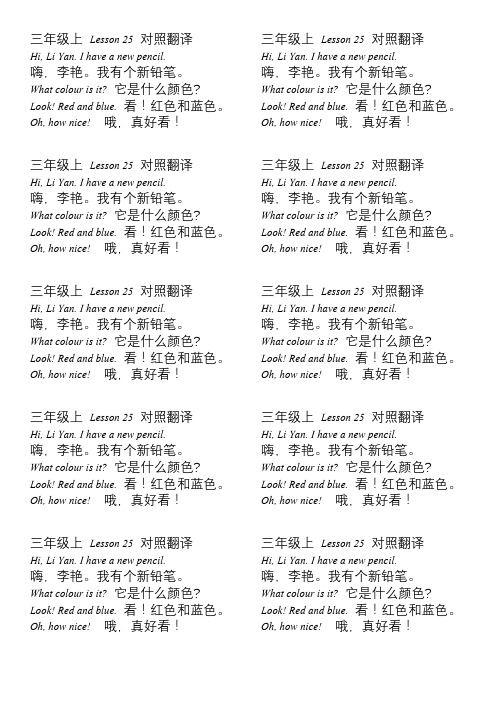
三年级上Lesson25 对照翻译Hi, Li Yan. I have a new pencil.嗨,李艳。
我有个新铅笔。
What colour is it? 它是什么颜色? Look! Red and blue. 看!红色和蓝色。
Oh, how nice! 哦,真好看!三年级上Lesson25 对照翻译Hi, Li Yan. I have a new pencil.嗨,李艳。
我有个新铅笔。
What colour is it? 它是什么颜色? Look! Red and blue. 看!红色和蓝色。
Oh, how nice! 哦,真好看!三年级上Lesson25 对照翻译Hi, Li Yan. I have a new pencil.嗨,李艳。
我有个新铅笔。
What colour is it? 它是什么颜色? Look! Red and blue. 看!红色和蓝色。
Oh, how nice! 哦,真好看!三年级上Lesson25 对照翻译Hi, Li Yan. I have a new pencil.嗨,李艳。
我有个新铅笔。
What colour is it? 它是什么颜色? Look! Red and blue. 看!红色和蓝色。
Oh, how nice! 哦,真好看!三年级上Lesson25 对照翻译Hi, Li Yan. I have a new pencil. 嗨,李艳。
我有个新铅笔。
What colour is it? 它是什么颜色? Look! Red and blue. 看!红色和蓝色。
Oh, how nice! 哦,真好看!三年级上Lesson25 对照翻译Hi, Li Yan. I have a new pencil.嗨,李艳。
我有个新铅笔。
What colour is it? 它是什么颜色? Look! Red and blue. 看!红色和蓝色。
Oh, how nice! 哦,真好看!三年级上Lesson25 对照翻译Hi, Li Yan. I have a new pencil.嗨,李艳。
三年级英语上册 Unit 3 Lesson 25Family课件 冀教
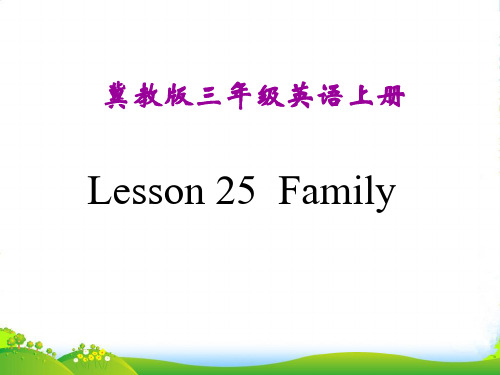
She is crying(哭).
•1、纪律是集体的面貌,集体的声音,集体的动作,集体的表情,集体的信念。 •2、知之者不如好之者,好之者不如乐之者。 •3、反思自我时展示了勇气,自我反思是一切思想的源泉。 •4、在教师手里操着幼年人的命运,便操着民族和人类的命运。一年之计,莫如树谷;十年之计,莫如树木;终身之计,莫如树人。 •5、诚实比一切智谋更好,而且它是智谋的基本条件。 •6、做老师的只要有一次向学生撒谎撒漏了底,就可能使他的全部教育成果从此为之失败。2022年1月2022/1/192022/1/192022/1/191/19/2022 •7、凡为教者必期于达到不须教。对人以诚信,人不欺我;对事以诚信,事无不成。2022/1/192022/1/19January 19, 2022 •8、教育者,非为已往,非为现在,而专为将来。2022/1/192022/1/192022/1/192022/1/19
冀教版三年级英语上册
Lesson 25 Family
爸爸
妈妈
女儿
儿子
This is Li Ming’s _______.
This is Li Ming’s ______.
: What are they doing? : They are playing.
He is laughing(笑).
They are talking(谈话).
They are singing(唱歌).
See you ne
冀教版三年级上册课文翻译
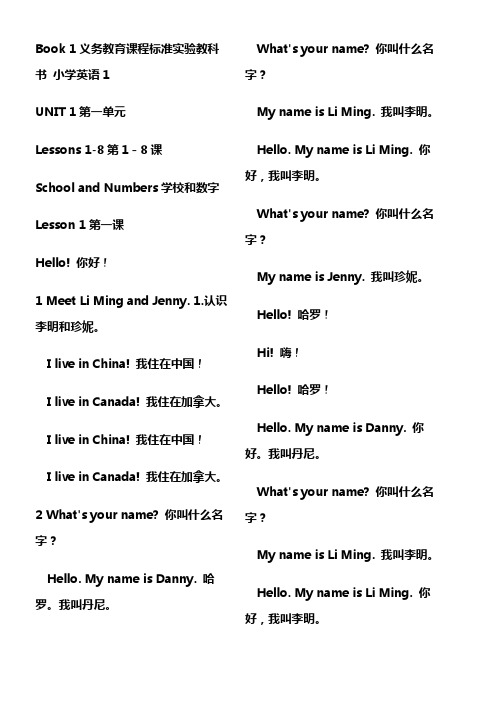
Book 1义务教育课程标准实验教科书小学英语1UNIT 1第一单元Lessons 1-8第1-8课School and Numbers学校和数字Lesson 1第一课Hello! 你好!1 Meet Li Ming and Jenny. 1.认识李明和珍妮。
I live in China! 我住在中国!I live in Canada! 我住在加拿大。
I live in China! 我住在中国!I live in Canada! 我住在加拿大。
2 What's your name? 你叫什么名字?Hello. My name is Danny. 哈罗。
我叫丹尼。
What's your name? 你叫什么名字?My name is Li Ming. 我叫李明。
Hello. My name is Li Ming. 你好,我叫李明。
What's your name? 你叫什么名字?My name is Jenny. 我叫珍妮。
Hello! 哈罗!Hi! 嗨!Hello! 哈罗!Hello. My name is Danny. 你好。
我叫丹尼。
What's your name? 你叫什么名字?My name is Li Ming. 我叫李明。
Hello. My name is Li Ming. 你好,我叫李明。
What's your name? 你叫什么名字?My name is Jenny. 我叫珍妮。
Hello! 哈罗!Hi! 嗨!Hello! 哈罗!Vocabulary词汇hello喂(表示问候)hi喂Lesson 2第2课Boy, Girl and Teacher男孩,女孩和老师。
1 Boy, girl or teacher?1.男孩,女孩还是老师?This is a teacher. 这是一位老师。
This is a boy.这是一个男孩儿。
This is a girl.这是一个女孩儿。
